Wild Flowers and Holy Sites of Israel
25 FEBRUARY – 5 MARCH 2020
FROM BURSARY RECIPIENT: CATHERINE CUTLER
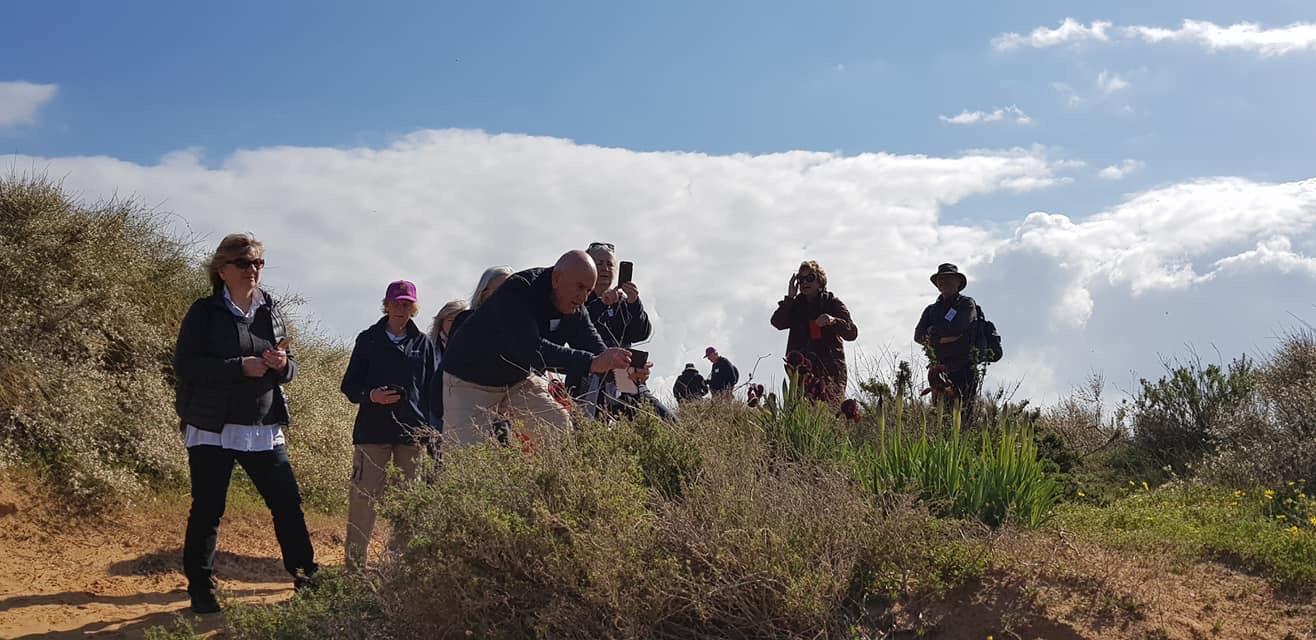
Plant hunting photo: Oron Peri
My Aims and Objectives:
- To experience the natural wonder of en-masse wildflower displays, especially geophytes, and understand the conditions required to achieve them
- To gain first hand exposure and increased knowledge of plants and crops I grow in the UK (under protection) by observing them in their native habitat
- To explore the less accessible far eastern reaches of the Mediterranean, and become acquainted with the unique flora of the region
- To meet and share experiences with Mediterranean Plants and Gardens (MPG) members
- To learn from renowned plantsman Oron Peri
- To gain first-hand experience of well-known bible land locations
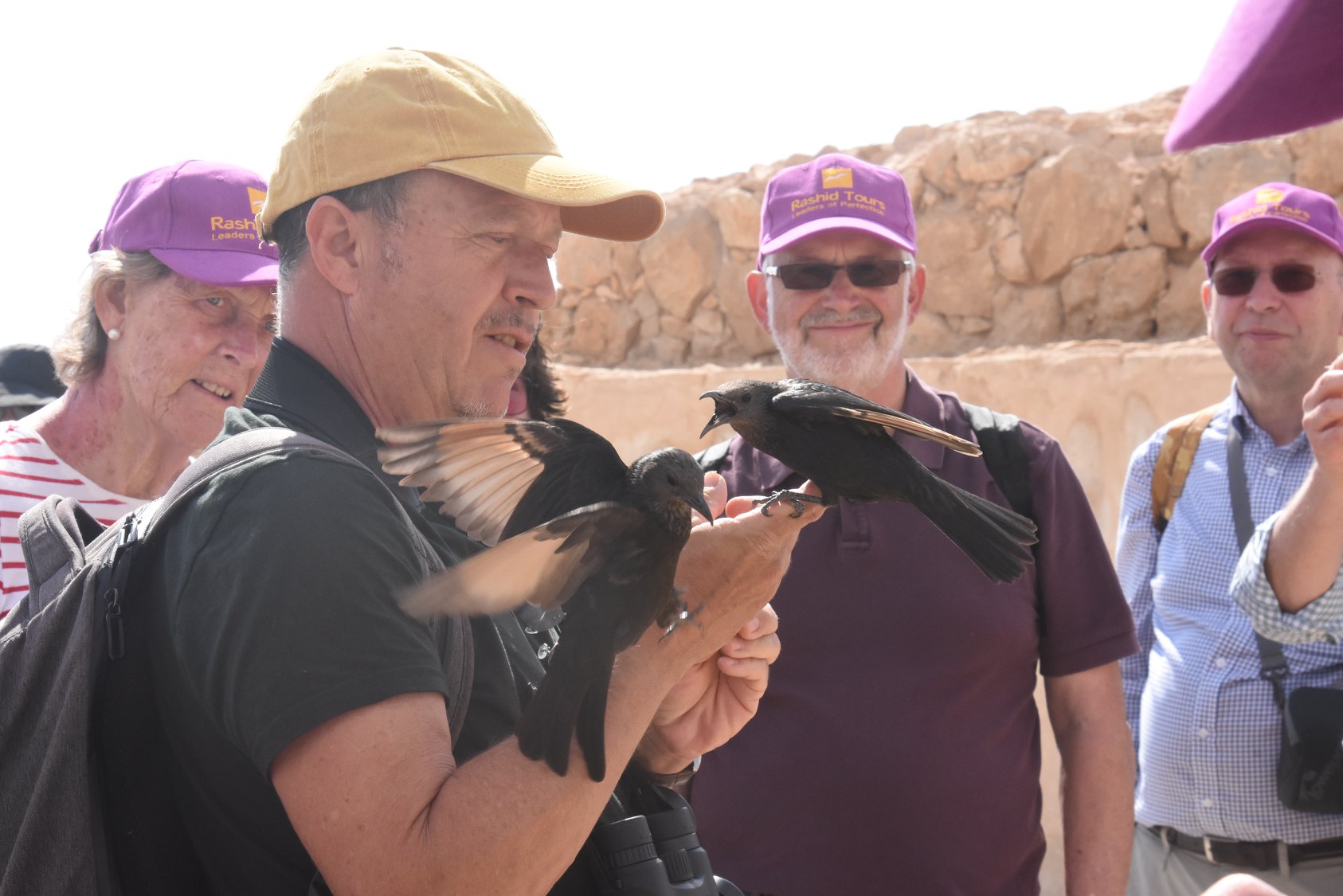
Oron Peri, bird whisperer
Overview:
In ten days, this trip gave a botanical overview of the entire country of Israel. For such a small country the diversity of habitats and number of native species – approximately 3,500 – is stunning. Israel is the furthest eastern reach of the Mediterranean Biome, where North Africa meets Asia and the Mediterranean, a meeting point for species from diverse habitats, and therefore supports a unique combination of flora. The itinerary included time within the coastal zone, on hills, mountains and in valleys, around the Sea of Galilee, the Dead Sea, in the desert and in Jerusalem. The majority of days were spent happily looking at wild plants, but a selection of diverse gardens were also visited, along with observation of Israel’s commercial horticulture en-route between destinations.
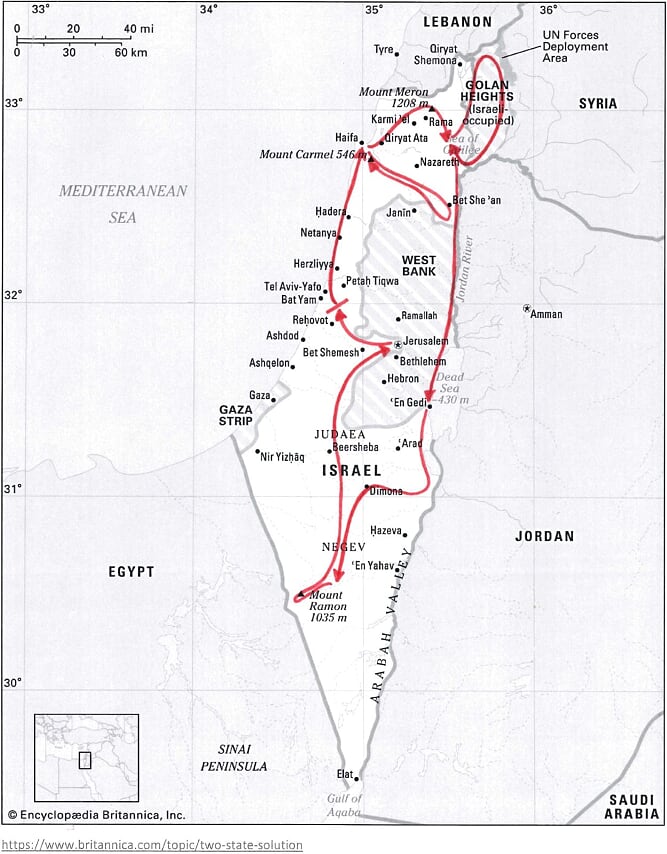
The timing of the trip coincided with the spring flowering, particularly spring-flowering geophytes, of which there were thousands. The particularly cool and incredibly wet winter immediately preceding the trip meant some bulbs in the northern areas were not in flower as anticipated, (flowering having been delayed by about four weeks), but these conditions gave us the privilege of seeing the desert in the south blooming. In addition, the wet weather ceased on our arrival, so we enjoyed warm, dry days for the majority of the trip.
The group comprised eight couples and eleven individual travellers who between them shared experiences from life in Italy, Spain, France, Greece, California, England and Scotland.
For those not entirely besotted by botany and gardening, the trip also included a great range of cultural experiences, and visits to historical and religious sites creating an engaging mosaic of experiences and focus.
The trip was expertly guided by Israeli, Oron Peri, a world expert on bulbs and Israel’s flora. In addition to sharing a plethora of botanical knowledge, Oron provided diverse cultural information and historic background to Israel in general, and to each destination. He cared for the group’s every need from morning to night, shared hard-earned insight on the best places to view Israel’s incredible flora, and also treated us to visiting his own bulb nursery, the highlight of the trip for many.
Coastal zone
Close to the sky-scraper city of Tel Aviv, and set within sand dune habitat is Poleg Iris Reserve, protecting the endangered, endemic Iris atropurpurea from encroaching development. These gorgeous, velvety Iris in shades from darkest purple to mid purply-brown, seemed almost too showy to be natural. The dominant dune shrub Retama raetam, was brimming with clouds of white flowers, their scent infusing the air. Lycium schweinfurthii and Ephedra aphylla provided a sub shrub layer whilst Anchusa tinctoria, Senecio joppensis, Maresia pulchella, Halimium sp., Ononis sp. cloaked the sand.
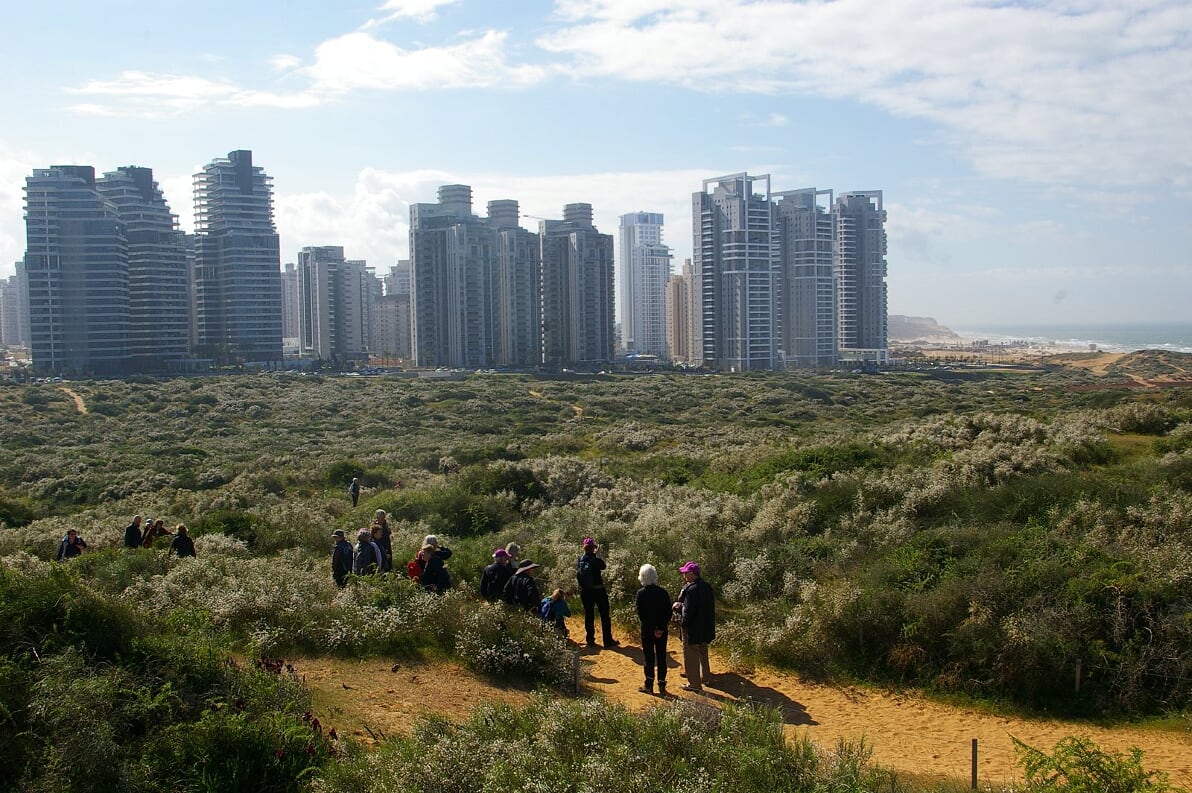
Development at Poleg Reserve with MPG group
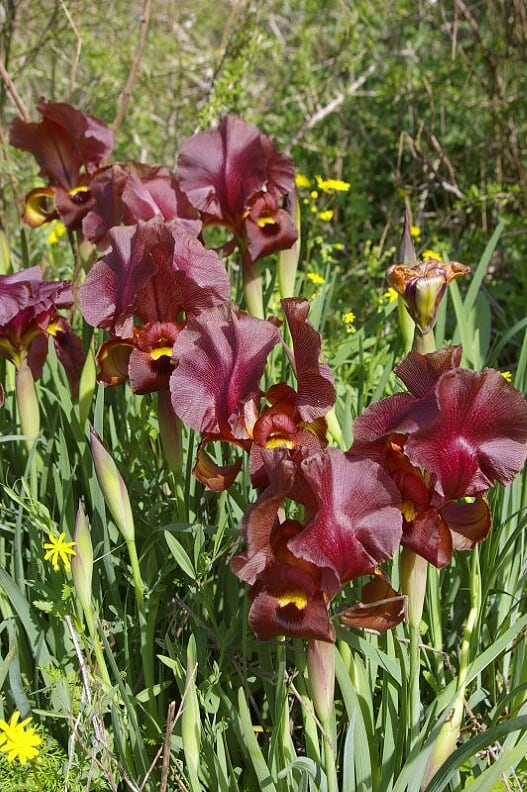
Iris atropurpurea at Poleg Reserve
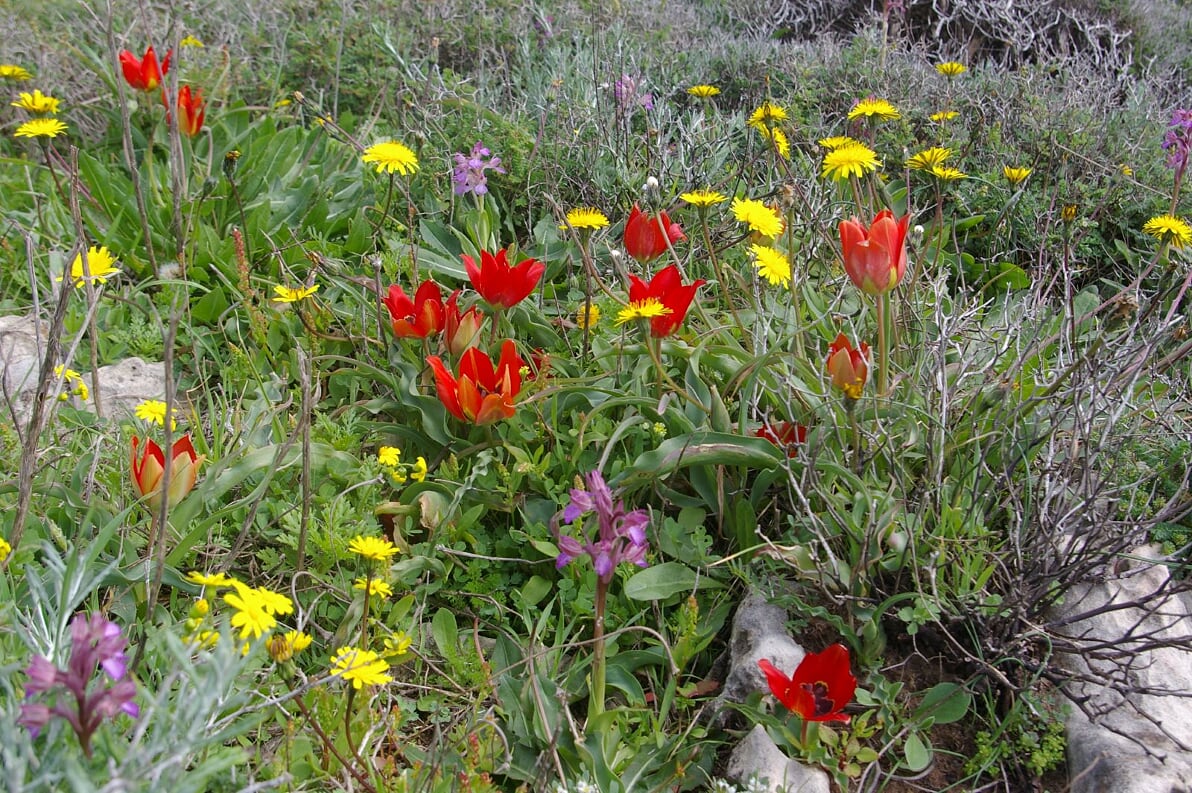
Tulipa agenensis sharonensis and Orchis papilionaceae at Habonim Reserve
urther north on a narrow strip of sandstone was the Habonim Reserve. Here the pocketed rock pavement allowed for a thin layer of good, light soil which supported dramatic Tulipa agenensis var. sharonensis. Familiar mastic shrubs, Pistacia lentiscus were wind-pruned low and wide, whilst Sarcopterium capitatum was the dominant shrub, both making ideal hiding places for the wild tortoises. Back from the shoreline, common orchids, Orchis papilionacea, abounded, along with more Senecio joppensis, Thymus sp., and Thymela hirsuta, along with flowering Gagea sp., Anemone coronaria, Cyclamen persicum and Gynandriris sisyrinchium.
A large lake, popular with migratory and wading birds was the feeding ground for spoonbills, who dutifully put on a display of synchronized ‘spooning’.
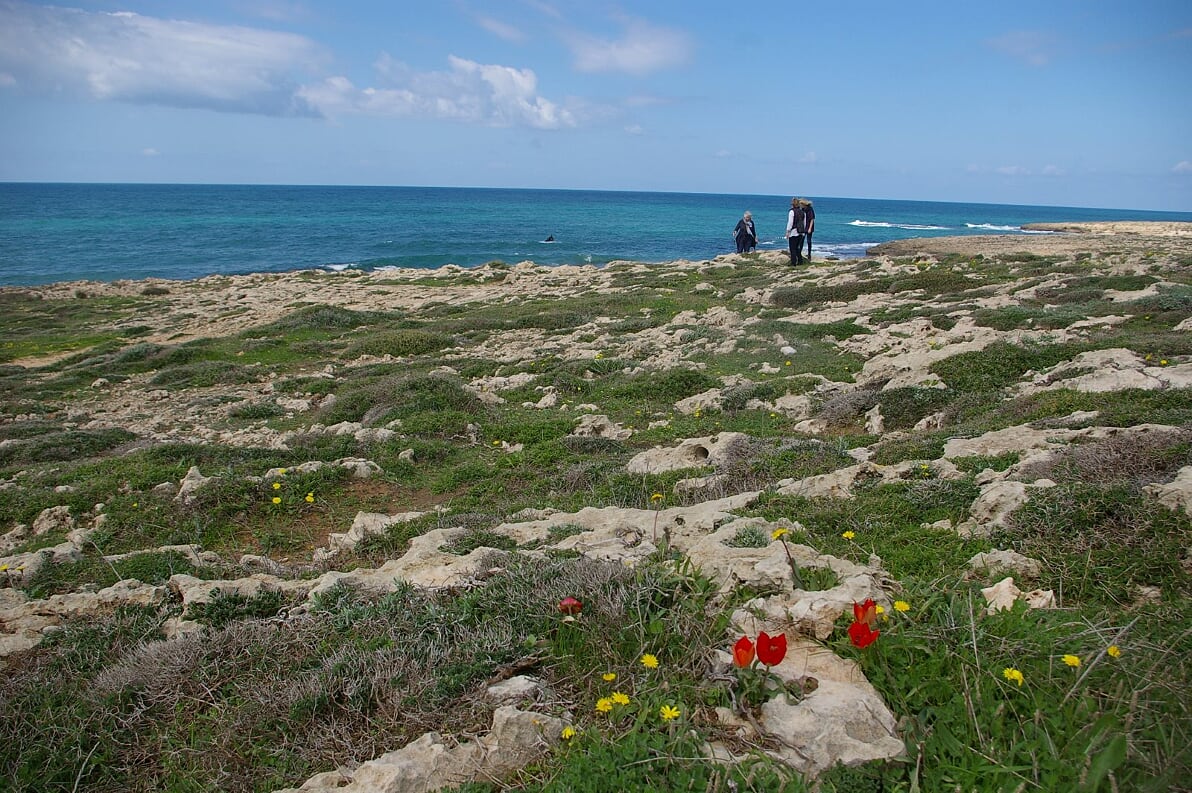
Habonim Reserve
Mountains and highland
Ancient mountains with familiar names became a reality on this trip.
On the slopes of Mount Carmel (where the prophet Elijah faced down the prophets of Baal) scarlet Anemone coronaria were revealed in their thousands, littering the hillsides below the olive trees and contrasting with bright yellow Oxalis sp. and acid green Euphorbia hierosolymitana. In comparison little grew below the Pinus halepensis trees. Mastic trees and carob trees, Ceratonia siliqua grew on the mountain’s rocky limestone slopes at around 500m altitude. A mellow late afternoon walk close to the summit provided perfect back-lighting to enjoy delicate flowers of Orchis punctulata, Bellevalia flexuosa, Scilla cilicica and the ubiquitous Asphodelus aestivus. The airy Quercus calliprinos woodland included occasional cinnamon-barked Arbutus andrachne and scented bay trees, Laurus nobilis. Less friendly plants included spikey Ruscus aculeatus, Smilax aspera and Asparagus sp.; but after seeing the havoc wrought by wild boars it is understandable that such plants abound! Oron introduced us to the wonderfully aromatic za’atar plant, Origanum syriacum.
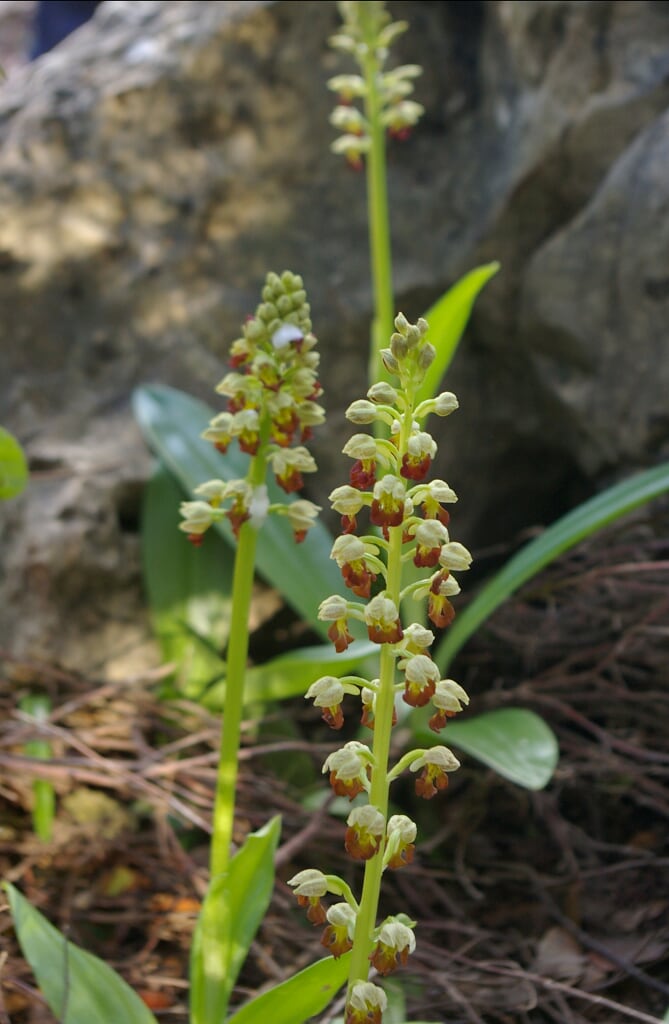
Orchis punctulata on Mt Carmel
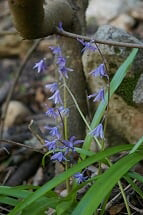
Scilla cilicica
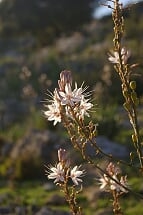
Asphodelus aestivus
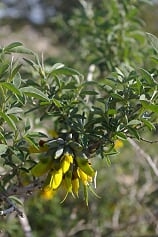
Anagyris foetida on Mt Gilboa
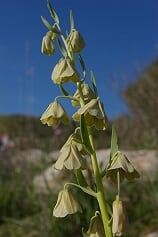
Fritillaria persica on Mt Gilboa
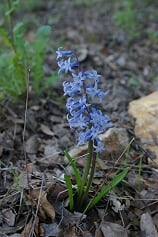
Hyacinthus orientalis at 700m
Oron expertly navigated us to a remote area of Mount Gilboa, where the beauty and tranquillity belied the raw truth of parking adjacent to the Palestinian/Israeli border fence. Sadly the Iris haynei were not yet flowering, however, majestic Fritillaria persica shot up amongst rocky outcrops, the pockets of which supported miniature gardens of Sedum sp. and Cyclamen persicum. Anagyris foetida shrubs flowered over Anemone coronaria, Lathyrus blepharicarpos and the common Senecio vernalis whilst Clematis cirrhosa (without its ‘freckles’) scrambled around. An open meadow of Silene egyptiana was our destination and close by a damp woodland meadow was lush with Ferrula communis. The mountainous scenery was outstanding, with far-reaching views across the country of Jordan.
Israel’s second highest mountain, Mount Meron, is in Israel’s wettest area, receiving 1500mm/year. Acres of Quercus coccifera cloak the mountainside and this is the most southern distribution for many Mediterranean plants. There are 24 orchid species found here, including the common Orchis papilionacea and rare Orchis israelitica, which we saw at 700m elevation, plus hybrids between them.
The mountain is a National Park and this area is kept free of grazing cattle in order to protect the orchids. The soil here, over limestone, was a gardener’s dream, rich and loamy, full of nutrients and leaf litter. The woodland, scented with bay, included wild olives Olea europaea and the rare evergreen sycamore, Acer sempervirens. Wild Hyacinthus orientalis, deeply scented like their garden counterparts, but with a lovely, airier form grew on woodland edges.
In open areas were typical Mediterranean shrubs, Phlomis sp., Cistus sp. and Calicotome villosa, and ground hugging Romulea bulbocodium and Valeriana dioscoridis.
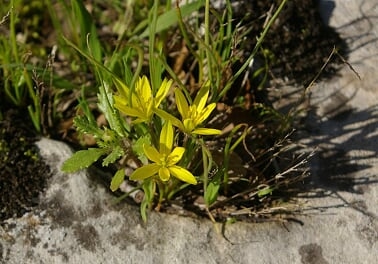
Gagea chlorantha on Mount Meron (at 1000m)
A picturesque mountain olive grove blazed with red anemones, and later, at 1000m altitude, we delighted in blooms of white, lilac, pink and red. At this altitude a plethora of diminutive plants flowered, including Gagea chlorantha (synonym G.damascena), Ornithogalum lanceolatum, the narcotic Mandragora autumnalis and the very lovely Ophrys israelitica (syn. O. fusca).
The mountain peak, at 1200m, is densely wooded, predominantly with Quercus calliprinos, along with Pistacia terebinthus subsp. palaestina, Arbutus andrachne and Pinus sp. and too high for anemone.
At 1500m, close to the Syrian border we visited the Odem forest, oak woodland of about six metres height, comprising Quercus coccinea, Q. ithabourensis and Q. boissieri. We enjoyed numerous Cyclamen coum amongst the leaf litter, adorable Veronica syriaca with happy little faces, and carpets of Ornithogalum lanceolatum in open grass
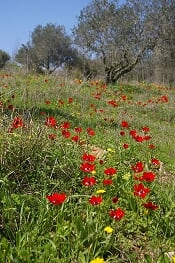
Anemone coronaria in olive grove on Mount Meron (at 700m)
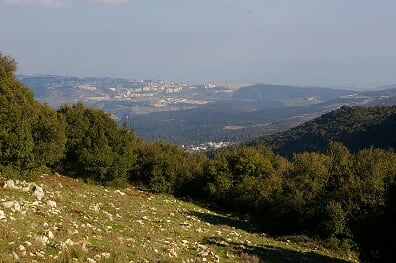
Oak woodland at Mount Meron peak (1200m)
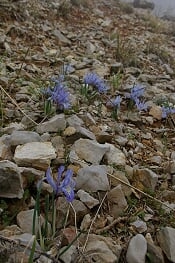
Iris histrio emerging from rock scree
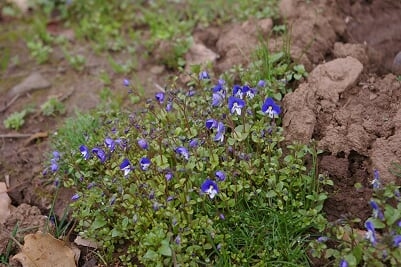
Veronica syriaca
The Golan Heights countryside was beautiful, an undulating plain with a patchwork of woodland, speckling of trees and peppered with rocks.
At the southern end of the Golan, Grant-Duff’s Nature Reserve is one of the few marshy areas in Israel. Here the elegant, flag-like Iris grant-dufii were at their peak, a cerise form of Anemone coronaria prevailed and an orange form of Asphodeline lutea. Interestingly, the wetlands also support a rich concentration of Narcissus tazetta. Sadly the Iris hermona were not yet flowering, which in itself must warrant another visit!
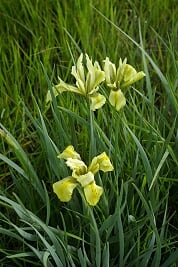
Iris grant-dufi at Grant Duffs Nature Reserve, Golan Heights
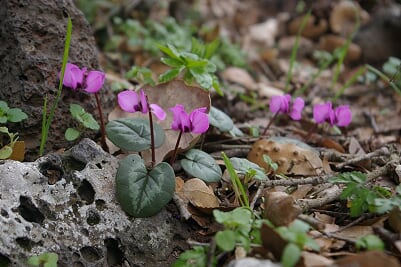
Cyclamen coum
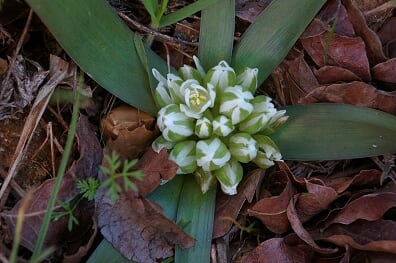
Ornithogalum lanceolatum at Mt Meron peak (1200m)
Desert
Covering over half of Israel, the Judean and Negev deserts lie west and south of the Dead Sea. These remote places, usually dry and barren with only 40mm rain annually, were green and flowering from the exceptional winter, which was wonderful to experience.
In salt-laden soil near the Dead Sea were some particularly interesting plants. The colourful hemi-parasitic mistletoes, Loranthus acacia, grew on Acacia tortilis, masses of Rumex cyprius, the prettiest dock imaginable, and Fagonia cretica with dainty flowers held above thick succulent leaves, to retain water, and spines to prevent herbivores. Also, the incredible Rose of Sharon Anastatica hierochuntica, a desert tumbleweed which tolerates drying out: when water comes the seemingly dead plant structure resurrects to release seed into a moist seedbed.
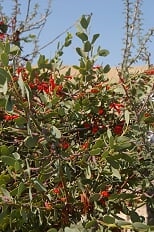
Parasitic Loranthus acacia near the Dead Sea
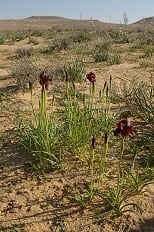
Iris hieruchamensis in eastern Negev
The steep, rocky hillsides of the eastern Negev support few plants, but above, on the sandy plateau, plants abounded as sand provides more moisture than other desert habitats. Wonderful
bulbous plants were aplenty, including scented Iris hieruchamensis in a range of purple tones and the also scented, but not so appealing, Biarum negevensis, a newly discovered and as yet undescribed species. Amongst billowing clouds of Diplotaxis acris and Rebouldia pinnata flowers, cute ground-hugging clumps Ornithogalum trichophyllum, pristine Leontice leontopetalum, and the amazing, utterly crazy, curly leaved Pancratium sickenbergeri were a few gems. This curly leaf adaptation enables the plant to shade and cool its own leaf surface. As we hunted for plants there was a surreal moment, as camels trooped across the hillside, a zeppelin floated overhead and numerous cranes, mesmerising in their migration, flew across the sky.
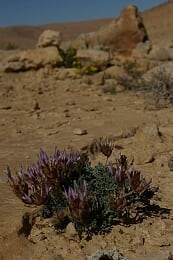
Astragalus sp. high western Negev (830m)
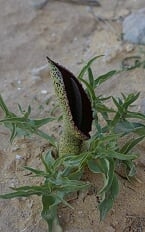
Biarum nevegensis
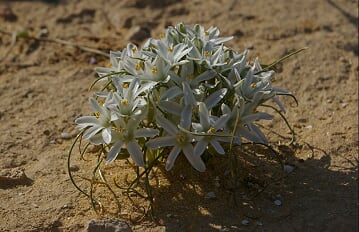
Ornithogalum trichophyllum in eastern Negev
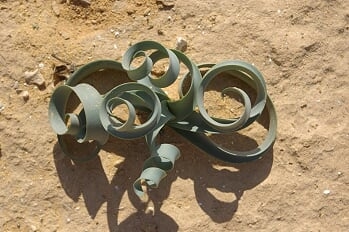
Pancratium sickenbergeri in eastern Negev
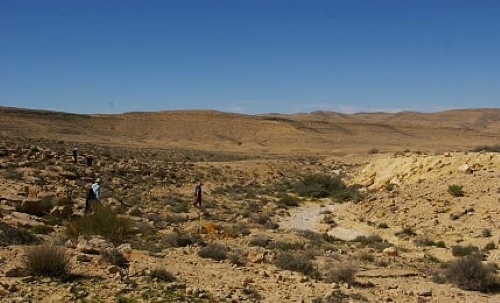
High western Negev (830m)
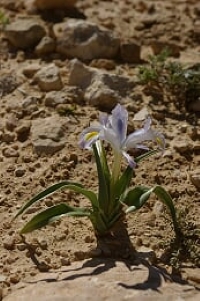
Iris regis-uzziae in high western Negev (830m)
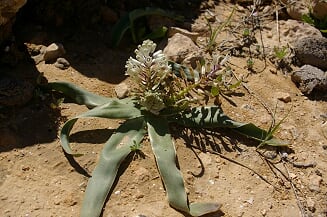
Bellevalia mosheovii (1000m)
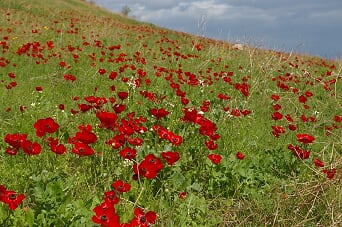
Ranunculus asiaticus (left) & Anemone coronaria (right)
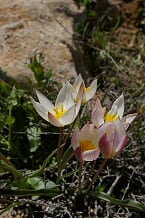
Tulipa biflora
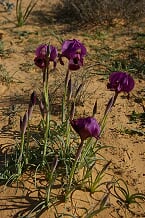
Iris mariae
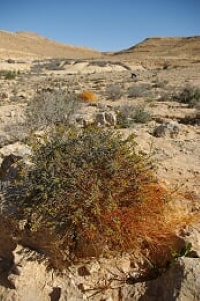
Parasitic dodder, Cuscuta sp. (830m)
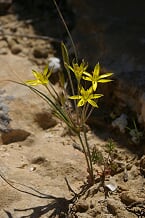
Gagea rigida (1000m)
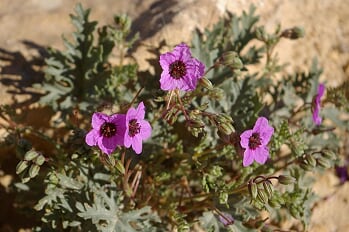
Erodium crassifolium (830m)
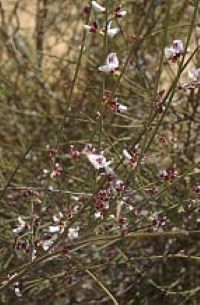
Retama raetam
Hill and Valleys
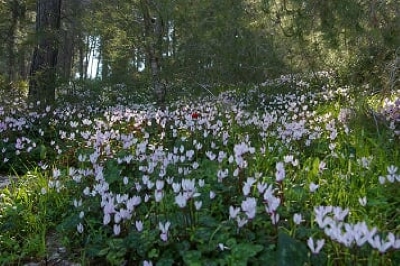
Cyclamen persicum in the Achiud forest
Lowland valleys of Israel are mostly farmed, filled with fields and polytunnels, yet some hillsides still retain native flora. In the Nazarene valley, a rare hillside woodland of Quercus ithaburensis (most were cut down by Ottomans many years ago) supported thousands of Cyclamen persicum plants, the cyclamen familiar as a winter bedding plant.
In a forest near Achiud in the upper Galilee region, the cyclamens were so plentiful that their sweet scent filled the air. Many orchids thrived here on the woodland margins, giving Oron the opportunity to share an orchid sex education lesson! This was primarily a pine forest, but with Pistacia sp. Carob, wild almonds, Amygdalus korschinskii and Ziziphus spina-christi around.
The Jordan valley is an intensive area for crops, but away from the fertile northern region, wild flowers littered the hillslopes. In northern Samaria, millions of red Ranunculus asiaticus (Persian buttercups) dominated, with the occasional orange bloom. White Allium palaestinum, blue Anchusa strigosa, yellow Calendula arvensis, pink and blue Alkanna strigosa, purple Salvia viridis, tall pink Silene sp., ubiquitous yellow Senecio, and just a speckling of red Anemone coronaria (their most southerly habitat), were some of the other many flowers creating beautiful and eye-catching roadside meadows. These fleeting meadows will be dry and brown by the end of March. Distinctive Trichodesma boissieri and edible Gundelia tournefortii suited drier environments, and were growing in a rocky gulley.
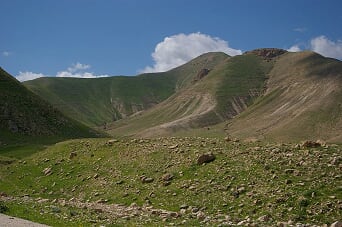
Samarian hillside in Jordan valley
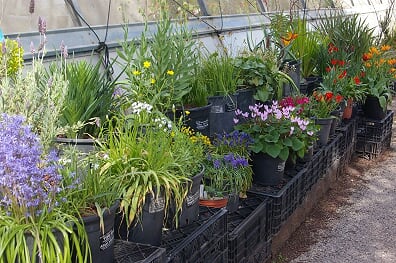
Display plants at Jerusalem Botanics
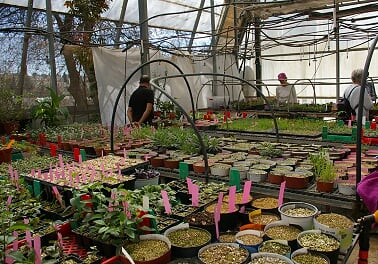
Nursery propagation house
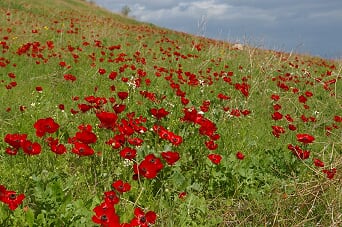
Ranunculus asiaticus in Jordan Valley
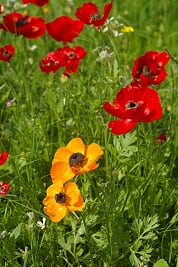
Ranunculus asiaticus
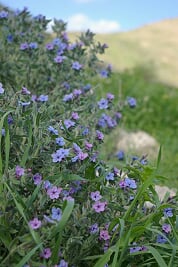
Alkanna strigosa
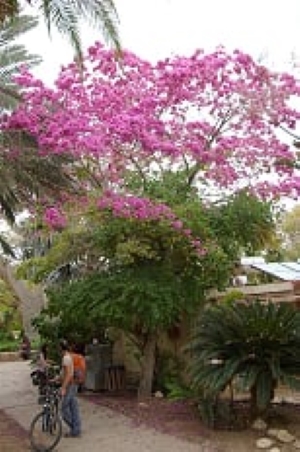
Tabebuia rosea
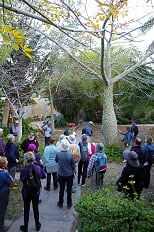
Chorisia speciosa
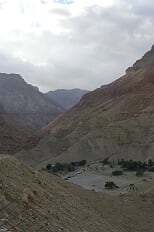
Locality of Kibbutz Ein-Gedi
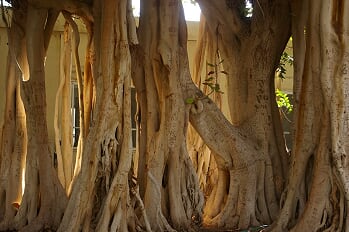
Ficus benghalensis at Kibbutz Ein-Gedi
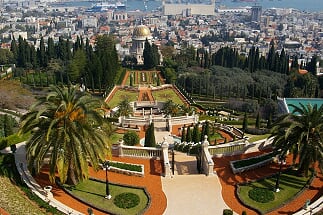
Baha’i gardens in Haifa
The Baha’i gardens in Haifa, so unlike anything else we saw, are a tribute to symmetry and formal design. The Persian influenced gardens are set across 19 formal terraces which radiate from a temple on the central terrace. Either side are less formal gardens grading into wildlife buffer zones further out. The gardens’ purpose is to beautify the holy site, the tomb and shrine of Bab the prophet.
Each terrace’s ‘recipe’ includes ‘lawn’, palms, water and a distinctive colour scheme provided by formal, traditional bedding. Tightly pruned hedges, lawns, trees and shrubs, along with the sharp, ornate lines of carved pale limestone, formal pools and tight rills, and carefully placed terracotta gravel created a crisp, colourful and dramatically manicured garden. The site welcomes over a million visitors each year, but maintaining such a pristine, sacred space is onerous. Around 80 gardeners (core staff and pilgrimage volunteers) care for the gardens, performing such tasks as griddling gravel by hand, manoeuvring lawnmowers up and down steep banks and pruning back living walls from stepladders. Chemical pesticides and herbicides are rarely used except for controlling red palm weevil, which is a serious threat. The garden has the benefit of a highly technical integrated control system for irrigation. Appearance and symmetry is everything, if a terrace palm were to become ill, both it and its corresponding mate would be removed; similarly, bedding is always well-known, tried-and-tested varieties to ensure success. In the more relaxed side gardens, succulents have been used to great effect in mixed planters and in mixed beds, pleasingly off-set by the vibrant red gravel. These geometric gardens provided a complete contrast to our other visits, were great to look at, but maybe not to linger.
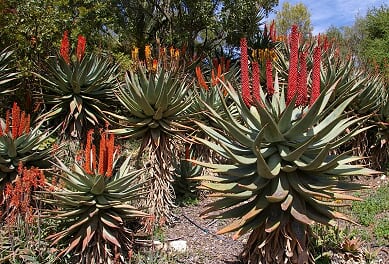
Aloe ferox
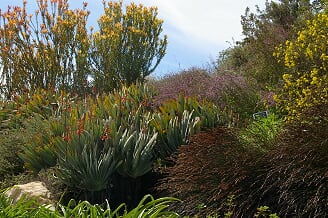
South African garden at Jerusalem Botanic
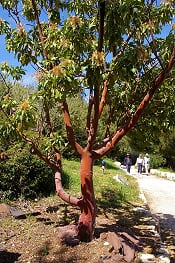
Arbutus glandulosa
Jerusalem Botanic Garden, found in the heart of the city, hopes to attract around 250,000 visitors a year and actively encourages links between different orthodox communities.
The 30-acre garden contains around 10,000 different plants, the largest range anywhere in Israel. During our visit the garden was only just emerging from winter, with deciduous trees still bare-branched, acacias flowering in the Australia garden and aloes in the South Africa garden. Seeing numerous species of aloe in close proximity was fantastic for comparison as most were flowering and labelled.
The South Africa garden also displayed wonderful examples of flowering Leucadendron ‘Safari Sunset’, Nytlandia spinosa and Bulbinella nutans. Other attention-grabbers were Arbutus glandulosa from Central America, and in the conservatory a tropical climber with butterfly like flowers, Dalechampia dioscoreifolia.
We were treated to a tour of the behind-the-scenes nursery, a candy-shop of young seedlings and potted plants. In addition to growing all plants for the garden, the nursery focuses on growing 250 different endangered Israeli plants, prioritising the critically rare. The team try many technical and creative approaches, such as trialling different substrate mixes, pre-germination treatments and pot types/sizes to ensure correct drainage for root establishment of different species. All propagation attempts are carefully recorded with the aim of establishing propagation protocols for these rare plants. When successful, plants are distributed to other Israeli gardens to protect them. November is the busiest time for the team with sowing seed, however their biggest challenge is successfully bringing plants through their summer dormancy in pots, and understanding their water requirements. For this reason, established geophytes were grouped by their dormancy and water requirements. The enthusiasm of the nursery team and their many students, interns and volunteers was palpable and we felt privileged to have this insight.
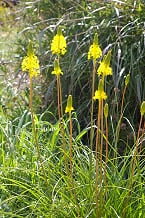
Bulbinella nutans
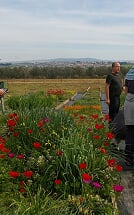
Oron Peri at his nursery
We were thrilled that Oron arranged a visit to his own commercial nursery near Yoqne’am. ‘Seeds of Peace’ has been established at this site for three years and specialises in seed production of geophytes. For ease of maintenance Oron grows geophytes in raised beds, using local soil, sand and crushed pumice as substrate. Some are grown under shade netting, and the whole nursery is fenced to protect the valuable plants from local badgers. Oron currently sells around 250 different seed lines through his website, exporting the majority, but retains a much greater collection at the nursery. Some flower heads had been bagged, to ensure no cross-pollination for the future seed supply. Oron is actively crossing cyclamen to raise new hybrids, a slow process as it takes four years for seed sown plants to reach flowering size.
The nursery looked amazing when we visited, with numerous plants flowering and many young seedling bulbs coming on. Some of the eye-catching gems were pink-flowering Anemone pavonina, sweetly scented Narcissus cordubensis, delicate Acis trichophylla, strongly scented Muscari macrocarpum, the most unusual crushed-strawberry coloured blooms of Romulea monadelpha and vibrant Lachenalia quadricolor. In addition to Mediterranean species, Oron grows a number of South African species; many of which would grow well in MPG members’ Mediterranean gardens.
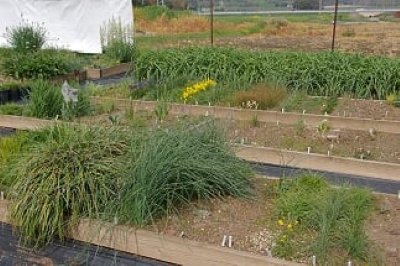
Seeds of Peace nursery beds
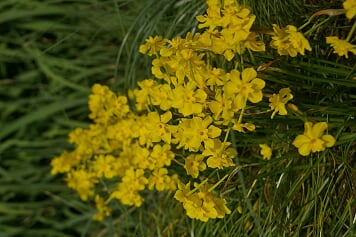
Narcissus cordubensis at Seeds for Peace nursery
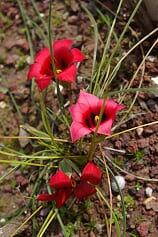
Romulea monadelpha
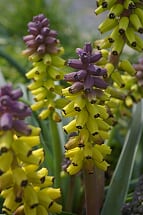
Muscari macrocarpum
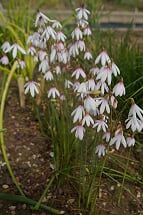
Acis tricophylla
Crops
Due to the wide range of conditions, temperature ranges (due to altitude), availability of water and some great soils, Israel is able to grow an incredibly diverse range of crops for its small size, from sub-topical to Mediterranean through to cool temperate. The country has a highly productive and technologically advanced agriculture and horticulture industry, with the majority of valleys (indeed anywhere remotely flat) being used for growing.
On the deep, fertile, stone-free, red soil of the Sharon coastal plain near Tel Aviv, grow citrus, vines, olives, avocados, potatoes and lentils, however in summer this soil turns rock solid. The limestone-based soils in the valleys surrounding Mount Carmel support numerous crops under cover, including loquats, cucurbits, tomatoes and bananas. Bananas are disease-prone, and although resistant varieties are available the flavour is poor, so the cover helps reduce infection. Almonds, a classic western Mediterranean crop, are grown alongside chickpeas, more typical of the eastern Mediterranean and Middle East by many kibbutz in the Nazarene and Jezreel valleys east of Haifa, utilising the great soil and conditions. Throughout the valleys were plastic covered fields, bringing on spring crops quickly while the ground was still moist.
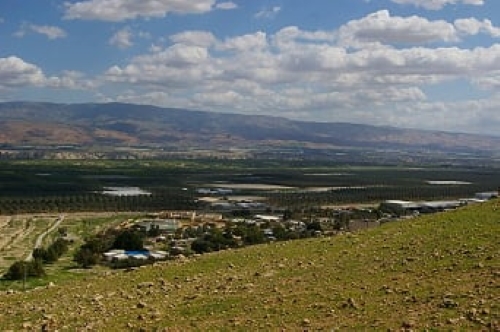
Jordan valley with dates and plastic
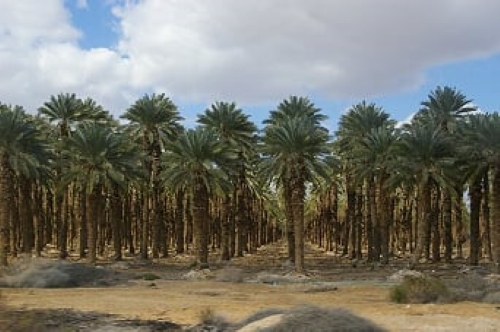
Medjool dates at the Dead Sea
Climbing from the coast to the Galilee region avocado orchards are common around Karmi’el and many olives are grown. These are Syrian olives, tough trees which produce good oil with bitter/strong fruit. In the plains north of the Sea of Galilee chickpeas are the main crop, however cranes love to eat them! The cranes are such a tourist attraction that they are encouraged, and farmers compensated for their losses. The hillslopes east of the Sea of Galilee grow almonds and olive groves and new, densely planted olive groves are in place, indicating buoyancy in Israel’s agricultural industry. On the hillslopes and valleys below Mount Gilboa acres of almonds are grown; immaculate rows of perfect trees which were in full flower of palest pink and white blooms during our visit. We later learnt these trees are sprayed with hormone to induce staggered flowering. Strategically placed bee hives ensure pollination. The valley areas and terraced hillsides on Mount Meron’s south-western slopes also support vines, olives and almonds, whilst the south-eastern slopes (near Safed) grow apricots and peaches. The hillslopes around Jerusalem were terraced and growing olives.
On Mount Carmel vines were growing outside, and have been nurtured here for over 5000 years. We saw dormant vines throughout Israel’s northern region, especially on the mountain slopes (and sometimes under cover in the valleys). In the coolest region of Israel, around Mount Hermon and towards the Syrian border, orchards of temperate top fruit are grown, apples, pears and cherries, along with Mediterranean fruits, pomegranates, nectarines, citrus, almonds, olives and pecan nuts. This is the most southerly extent for growing crops such as cherries, and the apples are renowned. As each crop flowers it must be a beautiful sight, and the nectarines were flowering when we visited. Reservoirs provide water for irrigating these trees, but supplies dry up in the summer.
The tumble-down stone walls across the Golan Heights suggest multi-generations of farming, but now, with a recent history of conflict and the land littered with land mines and inaccessible, very few crops are grown and cattle are kept inside barns.
In complete contrast, at 212m below sea level, the Sea of Galilee has subtropical conditions and reaches 45°C in the summer. Plants here were visibly further ahead than areas at higher altitude. Many acres are covered in plastic and irrigated to grow food. Banana fruit were bagged to protect the developing fruit from pests and disease. Mango and lychee orchards reflect the warmer conditions, with some brand-new plantings of closely spaced mango. The upper Jordan Valley is Israel’s most prominent growing area. This big, flat, fertile valley has a ready supply of water and is covered with well-maintained polytunnels and plastic, growing a whole host of crops including winter vegetables. Plantations include citrus, olives and dates.
By the Dead Sea are huge numbers of dates, the vast majority being the tasty ‘Medjool’ type which need heat and whose leaves have a lovely blue tint. Date palms are either male or female and bloom here in March. To assist good pollination (by wind) and fruiting, male flower spikes are cut off and placed in female trees. Male pollen is also collected and refrigerated till required, to puff directly onto the female flowers. Farmers can even, at a cost, buy pollen to use this way. Trees are productive for about 50-60 years and new plants are propagated slowly by air layering suckers. Even the soil exposed around the Dead Sea is used for growing vegetables, by firstly running fresh water through to leach out salts. Interestingly, the cherry tomatoes grown here are sweeter, due to the salty irrigation water. Even in the desert, enterprising Israelis grow crops, including prickly-pear and jojoba, and even vines in the upper Negev desert.
Cultural
It was wonderful to learn more about the state of Israel during the trip. The state is only 72 years old, and we were surprised and impressed at how technologically advanced it is (more so than the UK in parts). The country operates in three languages, Hebrew, Arabic and English and the impression gained of Israeli people is that they are calm, hard-working and straightforward.
Food was one of the highlights of the visit. The country prides itself on home grown fresh produce and this was enjoyed in the huge spreads at mezze style meals three times a day. Fresh, homemade lemonade was a real treat in a couple of smaller restaurants, whilst geranium cake, Pelargonium graveolens a new taste and za’atar became breakfast favourites. In Jerusalem the bustling fruit and vegetable market displayed Israel’s fantastic production, including unusual produce such as cyclamen leaves (winter alternative to vine leaves).
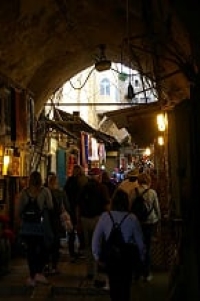
Exploring Jerusalem’s bazaar
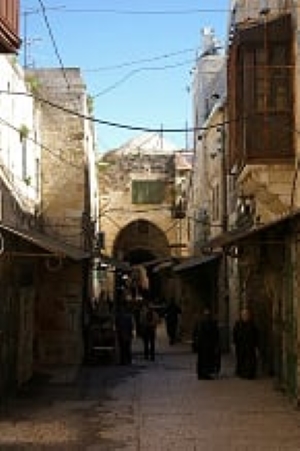
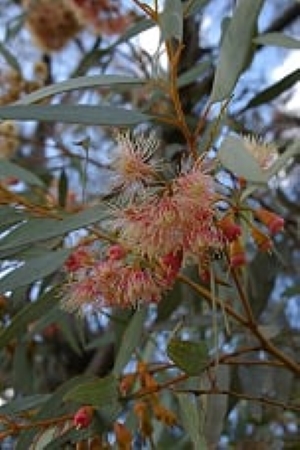
Eucalyptus torquata
The government put a lot of emphasis on ecology. Before Israel was formed, the forests were cut down for fuel, so Israel endeavours to reforest the land.
Every year school children from 8th grade have residential courses at one of 18 ‘field schools’ around the country where they learn about ecology and are part of the tree-planting programme. Pines used to be planted but have proved unsuitable as they are prone to fungal infections and disease, are not tolerant enough of the summer dryness and don’t improve biodiversity. Now only native trees are used, and we saw evidence that this is done well, with substantial staking and guards to prevent wild animals and livestock from damaging them.
Swampy areas were planted with eucalpytus (such as Eucalyptus torquata) to dry them out and increase agricultural land. However municipal plantings now always use native species.
To date over 250 million trees have been planted and around 75,000 acres of land are designated for future planting. Unfortunately the military and environmentalists often come into dispute over land.
Although there is currently relative peace, a strong military presence is felt throughout the country and there are many indications of war. Military personnel were seen most days, (including with arms catching the tram with us in Jerusalem!) The Golan Heights are internationally considered to be Syrian land held under Israeli occupation and Oron felt this disputed area may prove the trickiest of all to be agreed. The Syrian border has frequent watchtowers, telecommunication towers, abandoned tanks and even a UN headquarters. The Odem forest was full of bunkers, last used by Syrian snipers. Roads across the Golan Heights are lined with fence and frequent signs warn about landmines. These mines will take years to clear, good news for the native plants, as there is no access for people.
Although our travel through the eastern edge of Palestine was peaceable, the disputes between Israel and Palestine continue and there still remain constant and immense pressures on Palestinians living captive within their UN-assigned territory.
For many in our group it was interesting to see first-hand so many bible locations, including the lush Jordan River baptism site, the calm Sea of Galilee and bustling Jerusalem, where we visited the Garden of Gethsemane with its ancient Olive trees, witnesses to Christ’s betrayal over 2000 years ago, and the Holy Sepulchre.
A few of us walked the ancient city walls in Jerusalem where we spotted Antirrhinum siculum, Podonosma orientalis and Hyoscyamus aureus eking out an existences in the wall.
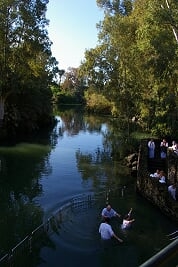
Baptism at the Jordan River
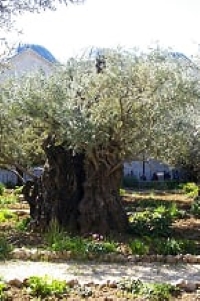
Ancient olive in Garden of Gethsemane
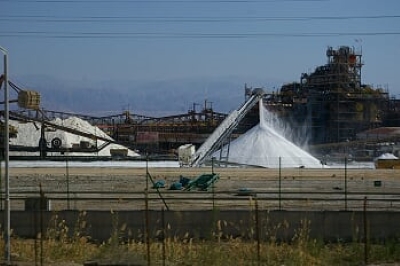
Phospate extraction at the Dead Sea
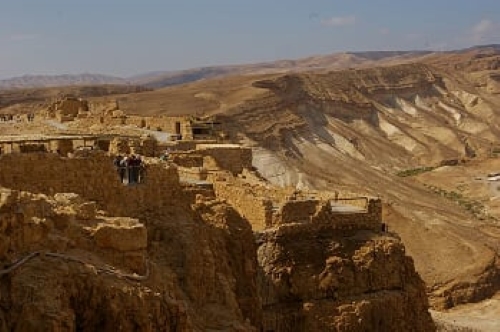
Masada and landscape to the west
Visiting the Dead Sea was quite an experience! At 430m below sea-level the sea is the lowest place on earth. The sea water is 33.7 per cent salinity and floating around in it was bizarre and it tasted foul The sea is in desert which only receives 4 cm rain a year and each year the level drops by 110 cm, such that it now consists of two separate bodies of water. However, rainwater falling on the Judean Mountains comes here, only taking a few hours and when it does arrive waterfalls form over the rocky escarpment west of the sea. It was in caves in this escarpment that the Dead Sea scrolls were found. The fresh water also dissolves underground salt deposits in the vicinity of the sea, causing sink-holes to open up.
On the southern shores commercial salt-settling pools are prevalent and there is an enormous processing plant extracting phosphates from the sea water, primarily for fertiliser. In this inhospitable landscape we enjoyed visiting the historical site of Masada. The fortress at Masada was one of Herod’s many palaces (Roman ruler 37BC to 4BC) and was strategically located as a refuge on an isolated rocky promontory along the escarpment. It had a vast storeroom complex and an incredible water storage system, which even facilitated private and communal bathing pools. After Herod’s death the palace became a stronghold community for rebels against the Romans. The Romans laid siege to the fortress and eventually the inhabitants (nearly 1000) chose to take their own lives rather than be captured, thus completing the Roman conquest of Judea.
Personal thoughts
The tour of Israel was all I hoped it would be and more. It’s one thing reading about places, quite another visiting them. From the very first morning, as Oron named the plants around us, it became apparent that parts of the flora were entirely different to anything I had experienced, with numerous endemics and species names such as ‘palaestina’ abounding. This made the trip especially interesting, challenging and exciting, and remained so for the whole duration.
Not being the most talkative of people, I wondered how I would fare travelling with a group of people, who I presumed would all already know each other. The reality was quite different, there were many individual travellers and only a few people knew one another already. People were welcoming and I thoroughly enjoyed getting to know the MPG members I travelled with, it was very enjoyable to ‘mix and match’ company through the day. Here I must mention how much I appreciated Cathy Rollinson the representative committee member on the trip ‘looking out’ for me, particularly in the first few days as I found my feet – thanks Cathy!
Israel itself surprised me, at how built up it was, especially in the coastal area, how technologically advanced and altogether how ‘western’. I had been concerned about our safety travelling in the country, and although it is far from stable I realised many of my fears were unfounded and I would happily visit again. Indeed this would be something I would love to do, to visit the same areas and other nature reserves at my own pace.
Oron set a very suitable pace, with typically just the right amount of time at any one location (quite a challenge). The places we visited were a fantastic array and clearly drew on Oron’s intimate knowledge of the country. The route also ensured we had very few drawn out periods on the coach and there was just enough walking at the locations for fitter members to get their daily exercise needs. The only improvement I can think of would be more loo stops in the mornings! Oron was a wonderful tour guide, sharing knowledge of his country but not talking incessantly.
I found it particularly interesting to visit so many of the bible land locations I read about in the new testament, and to absorb the atmosphere of the mountains, hills and valleys which will help me picture these areas so much more easily in the future.
Having been used to organising my own trips overseas, going on a pre-planned tour was both bizarre and wonderful. Bizarre, because I didn’t have in my head the route map and copious detail on the places we were to visit, wonderful because all the leg work was done and great decisions made by MPG already using ‘insider information’ and including private tours. Without the bursaries I received it would not have been possible for me to join the trip but I would certainly consider saving up to join something like this again in the future.
In the meantime, considering all I saw, I have been thinking about our spring displays in the Mediterranean Biome of the Eden Project and will be proposing some suggestions for future displays to trial.
This ten day trip to Israel was simply incredible. The range of sites visited, plants seen and knowledge gained was quite stunning. In addition to this, bonds were strengthened between MPG members and Oron’s expertise was second to none. Altogether a great success.
Acknowledgements
I would very much like to thank Mediterranean Plants and Gardens, the Cornwall Garden Society and the Royal Horticultural Society Coke Trust Bursary Fund for your generous bursaries which enabled me to participate in this trip, to have such a wonderful experience and learn so much. Thank you too to the MPG members who did such a good job arranging the trip and those who were so welcoming, Oron Peri for being so generous with his knowledge and colleagues for covering my absence.
Wild plants list:
Acacia tortilis (Dead Sea)
Acer sempervirens (Mount Meron 700m)
Adonis dentata (eastern Negev)
Aizoon hispanicum (high western Negev 830m)
Alkanna strigosa (Jordan valley)
Allium palaestinum (Jordan valley)
Allium israeliticum (Jordan valley)
Anagyris foetida (Mount Gilboa)
Anchusa strigosa (Jordan valley)
Anchusa tinctoria (Poleg Iris Reserve)
Anemone cononaria (Poleg Nature Reserve, Habonim Nature Reserve, Mount Carmel, Mount Gilboa, high western Negev 1000m, Golan Heights, Mount Meron 700m, Jordan valley)
Antirrhinum siculum (Jerusalem city wall)
Arbutus andrachne (Mount Carmel, Mount Meron 1200m)
Artemisia sp. (high western Negev 830m)
Arundo donax (Dead Sea)
Asparagus sp. (Mount Carmel)
Asphodeline lutea (Golan Heights)
Asphodelus aestivus (Mount Carmel)
Asphodeline lutea (high western Negev 1000m)
Asphodelus ramosus (eastern Negev, Golan Heights)
Astragalus caprinus (northern Negev)
Astragalus sp. (high western Negev 830m & 1000m)
Atriplex sp. (Jordan valley)
Bellevalia desertorum (high western Negev 830m)
Bellevalia eigii (high western Negev 1000m)
Bellevalia flexuosa (Mount Carmel)
Bellevalia mosheovii (high western Negev 830m)
Bellevalia zoharyi (high western Negev 830m)
Biarum negevensis (eastern Negev)
Calendula arvensis (Jordan valley)
Calicotome villosa (Mount Meron 700m)
Ceratonia siliqua (Mount Carmel)
Cistus sp. (Mount Meron 700m)
Clematis cirrhosa (Mount Gilboa, Mount Meron 700m)
Colchicum decaisnei (in leaf) (Mount Meron 700m)
Corydalis triternata (Golan Heights)
Cuscuta sp. (high western Negev 830m)
Cyclamen persicum (Habonim Nature Reserve, Mount Carmel, Mount Gilboa)
Cyclamen coum (Golan Heights)
Diplotaxis acris (eastern Negev)
Ephedra aphylla (Poleg Iris Reserve)
Erodium crassifolium (high western Negev 830m)
Erodium sp. (high western Negev 1000m)
Euphorbia hierosolymitana (Mount Carmel, Mount Gilboa)
Euphorbia ramonensis (high western Negev 830m & 1000m)
Fagonia cretica (Dead Sea)
Ferula communis (Poleg Iris Reserve, Mount Gilboa)
Fritillaria persica (Mount Gilboa)
Gagea sp. (Habonim Nature Reserve, high western Negev 830m)
Gagea commutata (Mount Meron 700m)
Gagea chlorantha (synonym G.damascena) (Mount Meron 1000m)
Gagea dayana (northern Negev)
Gagea rigida (high western Negev 1000m)
Gladiolis italicus (in leaf) (Mount Meron 700m)
Globularia arabica (high western Negev 830m)
Gundelia tournefortii (Jordan valley)
Gynandriris sisyrinchium (Habonim Nature Reserve)
Halimium sp. (Poleg Iris Reserve)
Helianthemum vesicarium (high western Negev 830m & 1000m)
Hordeum sp. (high western Negev 830m)
Hyacinthella nervosa (Jordan valley)
Hyacinthus orientalis (Mount Meron 700m)
Hyoscyamus aureus (Jerusalem city wall)
Iris atropurpurea (Poleg Iris Reserve)
Iris grant-dufii (Golan Heights)
Iris hieruchamensis (eastern Negev)
Iris histrio (Mount Hermon)
Iris mariae (northern Negev)
Iris regis-uzziae (high western Negev 830m)
Lathyrus pseudocicera (Jordan valley)
Laurus nobilis (Mount Carmel, Mount Meron 700m)
Lecokia cretica (Golan Heights)
Leontice leontopetalum (eastern Negev)
Leopoldia sp. (high western Negev 830m)
Loranthus acacia (Dead Sea)
Lupinus palestinus (Poleg Iris reserve)
Lycium schweinfurthii (Poleg Iris Reserve)
Maresia pulchella (Poleg Iris Reserve)
Matthiola livida (high western Negev 830m)
Moraea sisyrinchium (Jordan valley)
Moricandia sp. (high western Negev 830m & 1000m)
Olea europaea (Mt.Meron 700m)
Ononis sp. (Poleg Iris Reserve)
Orchis israelitica (Mt.Meron 700m)
Orchis papilionacea (Habonim Reserve, Mount Meron 700m)
Orchis punctulata (Mount Carmel)
Origanum syriacum (Mount Carmel)
Ophrys israelitica (synonym O.fusca) (Mount Meron 1000m)
Ornithogalum trichophyllum (eastern Negev, high western Negev 1000m)
Ornithogalum lanceolatum (Golan Heights, Mount Meron 1000m)
Oxalis sp. (Mount Carmel)
Panacratium maritimum (Poleg Iris Reserve, Habonim Reserve)
Pancratium sickenbergeri (eastern Negev, northern Negev)
Phlomis sp. (Mount Meron 700m)
Pinus halepensis (Mount Carmel)
Pinus sp. (Mount Meron 1200m)
Pistacia lentiscus (Habonim Nature Reserve, Mount Carmel)
Pistacia terebinthus subsp. palaestina (Mount Meron 1200m)
Plantago sp. (high western Negev 830m & 1000m)
Podonosma orientalis (Jerusalem city wall)
Prospero sp. (eastern Negev)
Pulicaria incisa (Dead Sea)
Quercus calliprinos (Mount Carmel, Mount Meron 1200m)
Quercus coccinea (Golan Heights, Mount Meron 700m, )
Quercus ithabourensis (Golan Heights)
Quercus boissieri(Golan Heights)
Ranunculus asiaticus (Jordan valley, high western Negev 1000m)
Rebouldia pinnata (eastern Negev)
Reseda sp. (high western Negev 830m)
Retama raetam (Poleg Iris Reserve, northern Negev, Jordan valley)
Romulea bulbocodium (Mount Meron 700m)
Rumex bucephalophorus (Poleg Nature Reserve)
Rumex cyprius (Dead Sea)
Ruscus aculeatus (Mount Carmel, Mount Meron 700m)
Salvia lanigera (eastern Negev, high western Negev 830m)
Salvia viridis (Jordan valley)
Sarcopterium capitatum (Habonim Nature Reserve)
Scabiosa sp. (high western Negev 830m)
Scilla cilicica (Mount Carmel)
Sedum sp. (Mount Gilboa)
Senecio joppensis (Poleg Iris Reserve, Habonim Nature Reserve)
Senecio vernalis (Mount Gilboa)
Senecio sp. (Jordan valley)
Silene egyptiana (Mount Gilboa)
Silene sp. (Jordan valley)
Smilax aspera (Mount Carmel)
Tamarix sp. (Dead Sea)
Thymus sp. (Habonim Nature Reserve)
Thymela hirsuta (Habonim Nature Reserve, northern Negev)
Trichodesma boissieri (Jordan valley)
Tulipa affinis systola (high western Negev 830m & 1000m)
Tulipa biflora (high western Negev 1000m)
Tulipa agenensis var.sharonensis (Habonim Nature Reserve)
Valeriana dioscoridis (Mount Meron 700m)
Verbascum fruticulosum (Jordan valley)
Veronica syriaca (Golan Heights, Mount Meron 700m)
Ziziphus christi-gali (Jordan valley)

